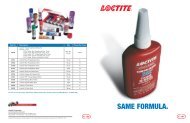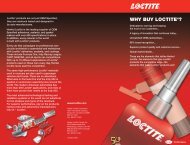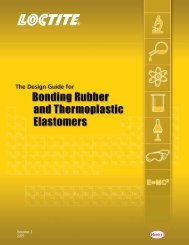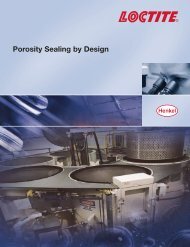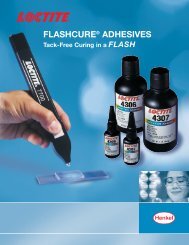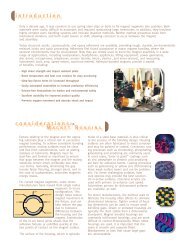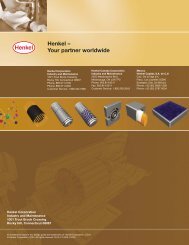Volume 4 - Loctite.ph
Volume 4 - Loctite.ph
Volume 4 - Loctite.ph
You also want an ePaper? Increase the reach of your titles
YUMPU automatically turns print PDFs into web optimized ePapers that Google loves.
Sodium TreatmentSodium treatment is carried out by immersing the substrate in anaggressive etching solution containing either a sodium-na<strong>ph</strong>thalenecomplex dissolved in tetrahydrofuran or a sodium-ammonia complexdissolved in ammonia. The etching process results in the dissolutionof the amor<strong>ph</strong>ous regions of the substrate’s surface, consequentlyincreasing the substrate’s surface roughness and potential formechanical interlocking. Moreover, sodium treatment introducesunsaturated bonds, carbonyl groups, and carboxyl groups to thesubstrate’s surface, which increases the substrate’s reactivity andwettability. Due to carbonaceous residue which results from thedefluorination of the surface, sodium treatment darkens the surfaceto an approximate depth of 1 micrometer. The on-part life of thetreatment is very long (years), however, heating and UV exposurerapidly degrade the treated surface. Major disadvantages of usingsodium treatments are extended exposure to the solution will resultin a substantial degradation of the substrate’s surface, the etchantsare highly hazardous, and the solution degrades very rapidly in thepresence of oxygen.Common uses: FluorocarbonsSurface GraftingSurface grafting is accomplished by grafting a chemical species to thesubstrate’s surface which increases the substrate’s bondability. Forexample, polyethylene can be exposed to gamma radiation in thepresence of vinyl acetate monomer, which then becomes chemicallygrafted to the polyethylene surface.Common uses: Vinylic Compounds on PolyolefinsSurface RougheningSurface roughening is a simple, low cost method of increasing thebondability of many plastics. Surface roughening increases thebondability by dramatically increasing the number of mechanicalinterlocking sites.Common uses: Effective for many plasticsThermal TreatmentThermal treatment increases the bondability of plastics by exposingthe plastic to a blast of hot air (approximately 500°C), which oxidizesthe surface. This mainly introduces carbonyl, carboxyl, and amidegroups to the surface, but some hydroperoxide groups are alsoformed. Very similar to flame treatments, this process also utilizes afree radical mechanism accompanied by chain scission and somecrosslinking. The improved bondability results from increasedwettability, due to the introduction of polar groups, and interfacialdiffusivity, caused by chain scissions.Common uses: PolyolefinsTranscrystalline GrowthTranscrystalline growth improves bondability of a plastic by moldingadherends against a high energy metallic substrate that inducestrancrystalline growth in the plastic’s surface regions. The metallicsubstrate induces the formation of crystallites at the plastic’s surfaceand results in rod-like or columnar s<strong>ph</strong>erulites that form inward fromthe interface. This is thought to strengthen the surface by driving lowmolecular weight material into the interior. In addition, some metallicsubstrates may oxidize the plastic’s surface, resulting in a substantialincrease in the reactivity and wettability of the plastic’s surface. Theeffectiveness of this treatment is dependent on such moldingconditions as the cooling rate and mold surface.Common uses: Polyolefins, Polyamides, PolyurethanesUV ExposureUV exposure increases the bondability of plastics by irradiating themwith high intensity UV light. However, the effectiveness of UV exposureis very dependent on the wavelength of light being used. For example,light with a wavelength of 184 nm will crosslink the surface ofpolyethylene, while light at 253.7 nm will not. UV irradiation causeschain scissions, crosslinking and oxidation of the polymer’s surface,even in inert gases. Many different mechanisms describing why UVexposure increases the bondability of plastics have been proposed,including: increasing the wettability; strengthening the plastic’sboundary layer through crosslinking; and inducing hydrogen bonding.The predominant view is that the bondability is improved by theformation of polymeric scission products, which promote interfacialflow, interdiffusion, and polar interactions.Common uses: Polyolefins76The <strong>Loctite</strong> ® Design Guide for Bonding Plastics, <strong>Volume</strong> 4



